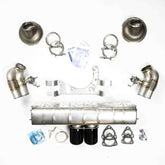Dundon Motorsports Minute: Tire Temperature
Refer to the video below on how to properly read your tire temperature for the best performance out of your Porsche.
VIDEO TRANSCRIPT:
Hey guys, Ted here with another Dundon Motorsports Minute. Today we're helping you go faster on the racetrack with the aid of a tire temperature gauge. The tire temperature gauge is really important to help you understand how you're using your tires and how you can adjust your setup and your driving to go faster. There are several different kinds of tire temperature gauges. Our favorite to use is the needle pyrometer which uses a little probe; you poke it directly into the tire tread to read the temperature. You can use an infrared gauge which is really simple and easy, but in our experience, the needle pyrometer provides better data, which is all in the pursuit of performance.
All right gang, to use a needle pyrometer temperature gauge the way that you do it is for the front particularly, you have someone turn the wheel all the way in one direction and then you're going to measure about an inch and a half in. You're going to poke it directly into the tread block pretty aggressively. You want to get it below the surface because the surface cools off a little bit faster. Then you're going to go to the center, push it in and get that reading, write it down. Then you're going to go to the innermost tread; about an inch and a half in from the innermost shoulder. Punch that in and get a reading. You're going to want to do this on all four tires and then take your readings, and then we can distill the information and figure out how to make the car faster.
All right now that we've taken our tire temperatures, we can begin to use this data. The data we're looking for helps us with three things; it tells us if our tire temperature is in the threshold that is best described by the manufacturer, that ideal temperature window for your tire to be in. That's going to vary based on what tire you're running. it's going to help us figure out if our alignment is dialed in based on the temperature difference across the section of the tire. We're looking to minimize the difference from inside to middle to outside if you get within 10 to 20 degrees Fahrenheit from inside outside you're on the right track. And it also helps us to determine if the tire pressure is ideal. A tire that is over inflated will wear will have the center of the tire be too hot. A tire that is under inflated will have the shoulders the outside edges of the tire get hotter than the center of the tire. We can use this data to make those adjustments to help us go faster. Once you've taken your data you can adjust your tire pressures, you can adjust your alignment, you can adjust your driving style and ultimately this is going to give you the most life out of your tires and gives you the best performance on the racetrack.






